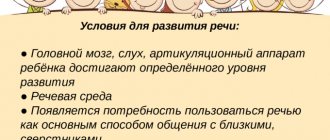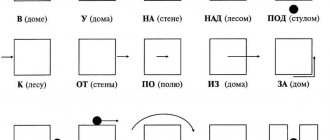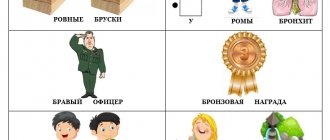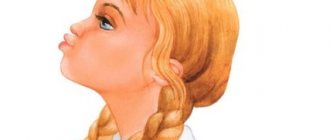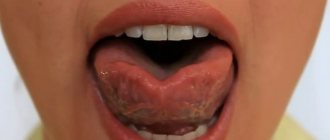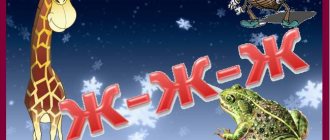The Tale of the Tongue
...or why some children don't make certain sounds?
Sometimes this happens by imitating the incorrect speech of others - not only adults, but also children and peers.
Therefore, try to make sure that your baby hears correct, beautiful speech much more often than defective speech: read children’s books aloud to him, let’s listen to recordings of fairy tales performed by professional artists... It is also very important to ensure that when communicating with your child you avoid “lisping” ", "children's speech". Often this is quite enough to overcome speech errors, and it is much more pleasant for the child to be spoken to as if he were an adult. The causes of impaired pronunciation may also be weakness of the muscles of the tongue and lips or a slight disorder of coordination of movements (inability to perform precise targeted movements with the tongue and lips). To check if this is the cause of your problems, tell your child “The Tale of the Merry Tongue” and watch how he performs the exercises. It’s good if during a fairy tale the child sees himself in the mirror.
The Tale of the Merry Tongue.
Once upon a time there was a Merry Tongue. Do you have a tongue? Show me. Merry Tongue had a house. The house is very interesting. What kind of house is this? Did you guess it? This is the mouth. That's what an interesting house Cheerful Tongue had. To prevent Merry Tongue from running out, his house was always closed. How is the house closed? Lips. Show me where your lips are. Do you see them in the mirror? But besides one door, this house has a second door. (Here you should smile so that your upper and lower teeth are visible.) What is the name of this door? Teeth. Show your teeth. Look at them in the mirror.
One day, Merry Tongue wanted to look at the sun and breathe some fresh air. First the first door opened. Show me how it opened. Yes, it remained open. Don't close the first door until I tell you to. (Normally, a child can hold this position for 5-6 seconds without twitching or pushing, the corners of the lips are stretched symmetrically.) Now let’s close the first door. We'll open it again. Let's close. (Repeat this exercise 3-4 times. Normally, the child performs the movement with full amplitude, without attenuation, easily, smoothly, quite quickly.) The doors to the Fun Tongue’s house opened, and he stuck out, but not the whole thing, just the tip. Tongue appeared and hid - it was cold outside.
In the house of the Merry Tongue there is a bed where he sleeps. Look how peacefully he sleeps. (The tongue lies spread out at the bottom of the mouth, without tubercles, calmly, motionless.) Let your tongue sleep just as peacefully. Don't wake him until I tell you to. (This position is also maintained by the child normally for 5-6 seconds without jolts and twitches, the side edges of the tongue are located symmetrically.) Let’s close the second door first, and then the first.
Our Tongue is very cheerful, he loves to have fun, jump, sometimes even reaches the ceiling. The ceiling in Tongue's house is called the palate. Let your tongue reach the ceiling and stroke the roof of your mouth. Now let the tongue reach the ceiling and sit there for a while. (The movement should be performed only by the tongue, without auxiliary movements of the lips and lower jaw. The mouth is wide open. Calmly, without twitching, the tongue is held at the top for 5-6 seconds.) Then the Cheerful Tongue went down and again jumped up to the ceiling. Came down. Jumped up... (The exercise is repeated several times. Normally, the child immediately finds the correct position of the tongue, performs the movements easily, quickly, with full amplitude.) The tongue jumped up, got tired and went to sleep. Let him rest a little.
The next day, Tongue decided to check again whether it had become warmer. When all the doors were open, Tongue looked out, looked left, right, up, down (the child must know the directions of movement of the tongue, immediately find the desired position, try to complete them in full), felt that it became colder and went into his house. First one door closed, and then the second. That's the whole tale about the Merry Tongue.
The reason that your child pronounces some sounds incorrectly may also be the insufficient development of his so-called phonemic hearing, that is, the ability to perceive by ear very subtle differences between the sounds of the Russian language, for example, between s and ts, r and l. How to check the state of phonemic hearing in a child? Play a game with him called "Echo". - Remember, you and I were in the forest and heard an echo? Let's play Echo. I will say something, and you repeat everything after me exactly like an echo. Ready? Repeat after me!
| Pa-pa-pa. Di-di-di...etc. Mom washed Mila with soap. | The ability to distinguish between hard and soft consonants is tested. |
| Bo-po-bo. Doo-doo-doo. Kidney-barrel. Year-cat. Daughter-dot-daughter. | The ability to distinguish between voiced and voiceless consonants is tested. |
| So-sho-so. Cha-cha-cha. Bear-bowl. Rat-roof-rat. | The ability to distinguish between whistling and hissing consonants is tested. |
| Ra-la. Lu-ru-lu. Spoon horns. Varnish, varnish, varnish. | The ability to distinguish between the sounds r and l is tested. |
If the child cannot repeat correctly due to the fact that he cannot pronounce a certain sound, use this technique: select appropriate pictures, toys or objects and ask the child to show you where Mila is, and where is soap, where is varnish, and where is cancer .
So, you have tested the child and determined the causes of the sound disorder. Perhaps he even had a peculiar “bouquet” of all three. What to do next? If your child is already five years old, quickly grab him under the arm and run to the nearest speech therapist. If he is not yet four, take your time; most likely, with age, everything will return to normal. And if your child is between four and five, special exercises will help him cope with “wrong” sounds.
Almost all preschool children have deficiencies in the pronunciation of one or more sounds, most of which are temporary and not permanent. They are due to the fact that in a child of this age the central auditory and speech apparatuses do not function well enough. The connection between them is not sufficiently developed and strong, the muscles of the speech apparatus are still poorly trained. All this leads to the fact that the movements of the child’s speech organs are not yet clear enough and coordinated. Therefore, in preschool age, the targeted development of mobility of speech organs and the ability to master them plays an important role.
Exercises for developing the muscles of the speech apparatus.
Before you start performing the exercises, read the recommendations for performing articulatory gymnastics.
Frog. Holding your lips in a smile, as if silently pronouncing the sound and. The front upper and lower teeth are exposed.
| Frogs really like to pull their lips straight towards their ears. They smile, laugh, and their eyes are like saucers. Like funny frogs, we pull our lips straight to our ears. They pulled and stopped. And not at all tired! |
Elephant. Stretching the lips forward with a tube, as if silently pronouncing the sound u.
| I imitate an elephant - I pull my lips with my trunk. And now I let them go and return them to their place. |
Elephant frog. Alternating lip positions: in a smile - with a tube. The exercise is performed rhythmically, counting.
| I will stretch my lips straight to my ears, like a frog. And now I’m a baby elephant, I have a proboscis. |
Fish. Calm wide opening and closing of the mouth. The exercise is performed rhythmically, counting.
Swing. The mouth is wide open, the lips are in a smile. We rhythmically change the position of the tongue: 1) the tip of the tongue behind the upper incisors; 2) the tip of the tongue behind the lower incisors. Only the tongue moves, not the chin!
| On the swing I swing up, down, up, down. And I rise higher and higher, up, down, up, down. |
Watch. The mouth is slightly open, the lips are stretched in a smile. The tip of the tongue alternately touches the left and right corners of the mouth. The exercise is performed rhythmically, counting. The chin doesn't move!
| Tick-tock, tick-tock, the clock goes like this. |
Spatula. The mouth is slightly open, the lips are stretched in a smile. A wide, relaxed tongue rests on the lower lip. This position is held for 5-10 seconds. If the tongue does not want to relax, you can pat it with your upper lip, while saying: five-five-five.
| The tongue is wide, smooth, resulting in a shoulder blade. And at the same time I count: one, two, three, four, five... |
Needle. The mouth is slightly open, the lips are stretched in a smile. Stick your narrow, tense tongue out of your mouth. Hold for 5-10 seconds.
| I pull the tongue forward, come up and inject. And again I will count: one, two, three, four, five... |
Needle spatula. Alternating tongue positions: wide-narrow. The exercise is performed rhythmically, counting.
| The tongue lies like a spatula and does not tremble at all. Then use a needle and pull the tongue with the point. |
Slide. The mouth is wide open, the lips are slightly smiling. The tip of the tongue rests on the lower teeth, the back of the tongue is arched. Hold for 5-10 seconds. Then the upper front teeth, with light pressure, are drawn along the back of the tongue from the middle to the tip.
| The back of the tongue will now become a little mound for us. Come on, hill, go up! We will rush down the hill. Teeth roll off the hill. |
Let's knock on the door. The mouth is wide open, the lips are slightly smiling. The tip of the tongue rests on the lower teeth, the back of the tongue is arched. Alternate the following movements: move the tongue deeper into the mouth and bring it closer to the front lower teeth. The exercise is performed rhythmically, counting.
Good luck!
What do you need to know before you start correcting sound pronunciation?
When setting up sound pronunciation, if several groups of sounds are impaired in a child, the basic sound for a specific group is first corrected. In the whistling group, the sounds are first corrected. Then, starting from it, they put on the sound z, after that they move on to the soft sounds sya and zi; The sound ts is placed last in the group of whistlers. In the hissing group, the sound sh is corrected first of all. Then, based on its articulation, the sounds zh, ch, shch are made. In the group of back-lingual sounds (k, k', g, g', x, x'), the main articulation of the sound k.
Corrective work begins with those groups that should appear in the child earlier than age-specific norms.
Sound correction is carried out in stages. There are usually four main steps:
preparatory,
sound production,
automation of sound and, in cases of replacing one sound with another or mixing them,
differentiation stage.
Each stage has its own tasks and work content. At all stages, we recommend developing fine motor skills, attention, memory, thinking, perseverance, focus, self-control, phonemic awareness, and correcting the grammatical aspect of speech; include exercises to prevent visual impairment, development of speech centers of the brain, i.e. something that will prepare the child for school and help him study well in the future.
Classes with the child should be carried out systematically, at least three to four times a week, supported by daily 2-3 short-term exercises. If classes are held less frequently, their effectiveness will sharply decrease. The child quickly loses the acquired skill, because in free speech, when self-control weakens, the baby will return to an incorrectly formed stereotype.
To conduct classes you will need various pictures. These should be either just objects, or drawings depicting some life situations. Various lotto games will help you here. Any books, magazines with illustrations will also help, and maybe you and your child will draw something yourself. Using painting material will make your work interesting and varied.
The timing of correct pronunciation depends on a number of factors: the degree of complexity of the deficiency, the individual and age characteristics of the child, and the regularity of classes. Sound production may take 1-2 lessons, and automation 3-4; or 5–7 lessons may be required just to prepare the articulatory apparatus for sound production. Both options are normal.
If you follow our recommendations, we have no doubt that you will get good results. But, if you worked diligently on this course with a child of 2-3 months, and the results are insignificant (not a single sound was delivered in accordance with age standards), we recommend that you seek advice from a speech therapist. You may need some advice, and independent work can be continued, or the child needs deeper help than it seems at first glance, and only a qualified specialist can provide it. It is useful for parents who have pronunciation deficiencies to study with their children.
Consistency is necessary when working on pronunciation. Don't rush to move on to the next step (or exercise) without mastering the previous one.
Deficiencies in pronunciation of sounds that are not corrected in a timely manner can remain for life. They are often found in adults. Speech shortcomings become fixed, and people, getting used to them, sometimes do not notice them. Sometimes it is believed that it is impossible to correct deficiencies in the pronunciation of sounds and other speech defects in adulthood. This is not true. With some effort, you can improve your speech and eliminate defects in sound pronunciation. To develop good diction, you must first strengthen the muscles of the tongue, lips and lower jaw, and establish proper speech breathing. Special exercises are used for this.
Speech breathing.
Correct speech breathing is the basis of sounding speech. It ensures normal voice and sound formation, maintains smoothness and musicality of speech.
Exercises for developing proper speech breathing.
1. Choose a comfortable position (lying, sitting, standing), place one hand on your stomach, the other on the side of your lower chest. Take a deep breath through your nose (this pushes your stomach forward and expands your lower chest, which is controlled by both hands). After inhaling, immediately exhale freely and smoothly (the abdomen and lower chest return to their previous position).
2. Take a short, calm breath in through your nose, hold the air in your lungs for 2-3 seconds, then exhale long, smoothly through your mouth.
3. Take a short breath with your mouth open and, with a smooth, drawn-out exhalation, pronounce one of the vowel sounds (a, o, u, i, e, s).
4. Smoothly pronounce several sounds on one exhalation: aaaaa aaaaaooooooo aaaaauuuuuu
5. Count on one exhalation up to 3-5 (one, two, three...), trying to gradually increase the count to 10-15. Make sure you exhale smoothly. Count down (ten, nine, eight...).
6. Read proverbs, sayings, tongue twisters in one breath. Be sure to follow the instructions given in the first exercise.
The drop and the stone are chiseling. They build with their right hand and break with their left. Whoever lied yesterday will not be believed tomorrow. Toma cried all day on a bench near the house. Don't spit in the well - you'll need to drink the water. There is grass in the yard, there is firewood on the grass: one firewood, two firewood - do not cut wood on the grass of the yard. How thirty-three Egorkas lived on a hillock: one Egorka, two Egorkas, three Egorkas... I wonder how many Egorkas you can get on one exhale? ;O)
7. Read the Russian folk tale “Turnip” with correct inhalation during pauses.
Turnip.
Grandfather planted a turnip. The turnip grew very, very big. Grandfather went to pick turnips. He pulls and pulls, but he can’t pull it out. Grandfather called grandma. Grandma for grandpa, grandpa for the turnip, they pull and pull, but they can’t pull it out! The grandmother called her granddaughter. Granddaughter for grandma, grandma for grandfather, grandfather for turnip, they pull and pull, they can’t pull it out! The granddaughter called Zhuchka. The bug for the granddaughter, the granddaughter for the grandmother, the grandmother for the grandfather, the grandfather for the turnip, they pull and pull, they can’t pull it out! Bug called the cat. Cat for Bug, Bug for granddaughter, granddaughter for grandmother, grandmother for grandfather, grandfather for turnip, they pull and pull, they can’t pull it out! The cat called the mouse. Mouse for the cat, cat for the Bug, Bug for the granddaughter, granddaughter for the grandmother, grandmother for the grandfather, grandfather for the turnip, pull and pull - they pulled out the turnip!
Practiced skills can and should be consolidated and fully applied in practice.
Working on diction.
Diction means a clear, clear and distinct pronunciation of all sounds of the native language with their correct articulation with a clear and intelligible pronunciation of words and phrases. Clear and precise pronunciation of words is ensured by the correct articulation of each sound, and above all by the ability to open the mouth freely and wide enough during speech. When the mouth is poorly opened, sounds are pronounced as if through teeth. To develop mobility of the lower jaw muscles and the ability to open the mouth wide enough during speech, special exercises are used.
Exercises to develop mobility of the lower jaw.
1. Freely lower your lower jaw until there is a two-finger gap between your teeth.
2. Silently, lingeringly (on one exhalation), say vowels: aaaaaaaaaaaaaaaaaaaaaaaaaaaaaaaaaaayayayayayayayayayayayayayayayayayayayayayayayayayayayayayayayayaya (the distance between the teeth in two fingers); ooooooooooooooooooooooooooooooooooooooo (the distance between the teeth is one finger); iiiiiiiiiiii (mouth slightly open).
3. Pronounce vowel sounds with your voice: aaaaaaaaaaaaaaaaaaaaaaaaaaaaaaaaaaaaaaaaaaaaaaaaaaaaaaaaaaaaaaaaaaaaaaaaaaaaaaaaaaaaaaaaaaaaaaaaaaaaaaaaaaaaaaaaaaaaaaaaaaaaaaaaaaaaaaaaaaaaaaaaaaaaaaaaaaaaaaaaaaaaaaaaaaaaaaaaaaaaaaaaaaaaaaaaaaaaaaaaaaaaaaaaaaaay
4. Pronounce several vowel sounds together and drawn out in one exhalation: aaaaaaaaaaaaaaaaaaaaaaaaaaaaaaaaaaaaaaaaaaaaaaaaaaaaaaaaaaaaaaaaaaaaaaaaaaaaaaaaaaaaaaaaaaaaa, etc. Make sure that when pronouncing sounds, the mouth opening is sufficiently full.
5. Say proverbs, sayings, and tongue twisters that are rich in vowel sounds that require a wide opening of the mouth.
Small, but smart. Two of a Kind. I found a scythe on a stone. Know the edge, don't fall. Like the fisherman, like the fish. A rolling stone gathers no moss. The snake has a bite, the hedgehog has a hedgehog.
7. Read the poem, clearly pronouncing the sounds a, z.
The sky was already breathing in autumn, the sun was shining less often, the day was getting shorter, the mysterious canopy of the forests was revealed with a sad noise, fog was settling on the fields, a caravan of noisy geese was stretching to the south: a rather boring time was approaching; It was already November outside...
A. Pushkin
While performing the exercises, make sure that the lower jaw drops freely downwards; first pronounce vowel sounds with a little emphasis.
Exercises to develop lip mobility.
With sluggishness and insufficient mobility of the lips, the clarity and clarity of the pronunciation of many vowels and consonants suffers. So, to pronounce the sound u(yu) you need to stretch your lips forward like a tube, for o(е) you need to round your lips, for s(z) you need to stretch your lips in a smile, etc. The following exercises are useful for developing lips.
1. Stretch your lips into a smile without exposing your teeth.
2. Stretch your lips in a smile with your teeth exposed and your mouth closed.
3. Pull your lips tightly closed forward (as when whistling).
4. Pull your lips forward in a tube shape.
5. Alternate between pulling your lips into a tube and stretching them into a smile.
6. Lift your upper lip, exposing your upper teeth, then lower your lower lip, exposing your lower teeth.
7. Pronounce vowel sounds in a drawn-out manner (first without a voice, but with emphasized articulation, then with a voice).
aiiiiii (lips stretched into a smile); oooooh (oval lips); uuuuu (lips like a tube).
8. Say consonant sounds (first silently, then with voice):
ssssss, zzzzzz (lips stretched in a smile); shhhhhhh, zhzhzhzhzh (lips extended forward in an oval shape).
9. Pronounce several sounds in a continuous and drawn-out manner on one exhalation:
eeeeeeeee (the lips are first stretched, then take the shape of a tube); uuuuiiiiii (lips change from a tube shape to a smile shape); ooooooooooo (rounded, tube, smile); aaaaaaaaaaaand etc. ssssssshshshsh (when pronouncing a sound the lips are stretched, when pronouncing w they are extended forward); zzzzzzzhzhzhzh (when pronouncing z, stretch your lips, when pronouncing w, stretch your lips forward).
10. With lips tightly closed, form an explosion when pronouncing the sounds p, b (dad, baba, bagel, cereal, drum, stick).
11. Strengthen the clarity and clarity of pronunciation of sounds in words:
willow, game, iron, lesson, scrap, perch, donkey, spinning top, lawyer, south, hedgehog, tree, Irina, institute, incubator, emerald, shelter, snail, rod, sensation, ophthalmologist, equipment, juice, lock, wheel, hat, school, beetle, belly, dryers, sun, iron, folder, drum, broom, bicycle, apron, sweatshirt, jacket.
When pronouncing words, watch the position of your lips in front of the mirror.
12. Read proverbs, sayings, tongue twisters. Make sure that your lips are positioned correctly and that your words and phrases are pronounced clearly.
Stand for each other and you will win the fight. You will learn from the smart, and you will unlearn from the stupid. Cabbage loves water and good weather. The wasp does not have whiskers, not whiskers, but antennae. The wolves are looking for food. The Christmas tree has pins and needles.
13. Read the story aloud and make sure that your lips take an active part in pronouncing sounds and words.
Bells.
I really love these simple flowers - cheerful bells. You will come out of the forest into an unmown meadow overgrown with tall grass and gasp with joy - there are so many different flowers flaunting, similar to a festive round dance. All over the green meadow, daisies are turning white, dandelions are turning yellow, and peas are blooming. And above all, most cheerfully, are the purple bells. From the light breath of the warm summer wind, the bells sway, bow, and silently ring, joyfully welcoming the guest. All summer long, the familiar and lovely flowers of our meadows and forests bloom, bells ring silently.
Exercises to develop the muscles of the tongue.
The tongue takes an active part in the formation of most speech sounds. The clarity of speech largely depends on its work. Particular difficulties arise when pronouncing words with a combination of consonants, when it is necessary to quickly switch the movement of the tongue from one position to another. To strengthen the muscles of the tongue, improve its mobility and switchability, before using exercises in pronouncing sounds, words and phrases with a cluster of consonants, clearly practice the following movements.
1. Stick your tongue out and move it left, right, up, down.
2. Stick your tongue out and make circular movements from left to right, then vice versa - from right to left.
3. With your mouth open and your tongue slightly protruding, make it wide, narrow, and cup (the tip and sides are slightly raised).
4. Using a slightly raised, tense tip of the tongue, “brush” the upper teeth from the outside and inside, in the direction from the inside of the teeth to the outside and vice versa.
Monitor the correct execution of movements using a mirror. Make sure that all tongue movements are performed easily and freely, without much tension.
Exercises in clearly pronouncing consonant sounds in syllables.
Read the syllables. 1. pa, po, pu, py, pe pya, pyo, pyu, pi, pe ta, then, tu, you, te cha, te, ty, ti, te sa, so, su, sy, se sia, syo , syu, si, se zha, zho, zhu, zhi, zhe
2. ap, op, up, ip, ep at, from, ut, yt, et as, os, us, ys, es ash, osh, ush, ish, esh
Exercises in clearly pronouncing words with a combination of consonant sounds.
Read aloud words with a combination of two, three and four consonant sounds: entrance, invest, luggage, tourist, map, flowerbed, service, tail, brush away, snatch, collect, roach, stamp, pimple, swaggering, platoon, swim, weave, set , move, spark, feed, canvas, look, grotesque, breast, cover, moment, smooth, tetanus, smooth out, tetanus, trunk, hawk, fires, sprats, emerge, open, health resort, fight, meet, overseer, uniform, warning , metro builder, colander, wandering, transcription.
Exercises in the clarity and clarity of pronunciation of sounds and words in phrasal speech.
To practice the precision and clarity of pronunciation of consonant sounds and words, it is useful to use tongue twisters, which are built on a combination of consonant sounds that are difficult to pronounce. Reading tongue twisters should begin at a slow pace, while clearly pronouncing each word and each sound. Gradually increase the pace, but make sure that the clarity of pronunciation does not decrease. Read the tongue twisters. Prokhor and Pakhom were riding on horseback. The jackdaw sat on a stick, the stick hit the jackdaw. From the clatter of hooves, dust flies across the field. The bull's white lip was blunt. The water truck was carrying water from the water supply system. Fenya has a sweatshirt, Faya has shoes. On seven sleighs, seven people sat in the sleigh themselves. The chick's chick clung tenaciously to the chain. Prokop arrived and the dill was boiling. Prokop left—the dill was boiling. Just as dill was boiling under Prokop, dill was boiling without Prokop. Mother gave Romasha whey from the yogurt. The bee buzzed and the spider buzzed. Scales on a pike, bristles on a pig. The cap is not sewn in the Kolpakov style, the cap should be re-packed, but the cap should be re-packed. There is grass in the yard, there is firewood on the grass: one firewood, two firewood - do not cut wood on the grass of the yard. The ships tacked, but did not tack. You can’t talk through all the tongue twisters, you can’t talk through all the tongue twisters quickly.
Say small tongue twisters in one exhalation. Maintain the smoothness and consistency of their pronunciation.
Further consolidation of good diction is carried out by reading aloud poetic and prose texts. At the same time, at first it is necessary to continue to monitor the work of the lips, tongue, lower jaw, the clear pronunciation of vowel sounds (stressed and unstressed), the clear pronunciation of consonants, but do not allow their pronunciation to be amplified or emphasized.
Each exercise is practiced until it can be performed easily and freely, without much tension.
When working on diction, it is necessary to take into account the correct use of speech breathing and voice. So, when pronouncing tongue twisters, it is necessary to correctly convey their content, pause appropriately, and get air in a timely manner.
Classes to practice good diction are held daily for 10-15 minutes. The transition to the next exercise is carried out only after the previous one has been worked out quite clearly.
Speech therapy master class for parents: “The Tale of a Merry Tongue”
MASTER CLASS FOR PARENTS
"The Tale of the Merry Tongue"
Target:
— Introduce parents to articulation gymnastics
— Create a positive emotional attitude towards speech therapy sessions
— Develop the creative skills of parents
Equipment:
— Individual mirrors
— Interactive board (to show articulatory poses)
— Booklets describing articulation exercises
Guidelines:
It is recommended to conduct a master class in a group of 8-10 people (small group) in order to relieve stress, increase the efficiency and quality of the proposed work
Progress:
The speech therapist greets the parents, and the topic of the master class is announced. We throw a flower into the circle and ask, passing the flower, to call each other affectionately. The flower is returned to the speech therapist.
“How affectionately and beautifully you called each other! Articulation organs, which actively develop in a child in the first 5 years of life, are responsible for beautiful and correct speech. Therefore, it is at this age that the articulatory apparatus should be actively developed. Today we will try to learn how this can be done not only in speech therapy classes, but also at home.”
“Pay attention to the slide (slide show), which indicates the fundamental rules for conducting articulatory gymnastics
:
- should be carried out daily in order to consolidate skills (2 times per
day 1
- maintain consistency in movements
- we carry out at a slower pace at first, then we can speed it up
- exercises with the child are carried out in front of a mirror in a playful way
- the articulatory position should be held for 5-10 seconds, gradually increasing the time
- monitor the accuracy and correctness of execution
- prevent the child from becoming overtired
- articulation gymnastics should not bore the child and be interesting
“There are quite a lot of articulation exercises, and in order to remember them, listen to the fairy tale about the Merry Tongue, which will help not only you and your children carry out tongue exercises with interest and ease.”
We ask parents to pick up mirrors.
“All the exercises that we will perform will be broadcast on a slide; the main task is to monitor the correct execution of the pose in an individual mirror.” The speech therapist performs it together with the parents and explains if necessary.
In one beautiful house (we open our mouth wide) lived the Cheerful Tongue (we show him). Early in the morning he woke up and looked out of the window (slide show). In Tongue's house there was a floor and a ceiling (slide show), and he loved to jump from floor to ceiling (slide show). One day, Tongue decided to paint the ceiling red (exercise “Painter”, slide show). One fine sunny day, Tongue went with friends to play football (Exercise “Football”, slide show) and the ball hit the fence (Exercise “Fence”, slide show).
There was a horse grazing behind the fence (exercise “Horse”, slide show), which was frightened by the ball and galloped away very quickly (exercise “Horse” at a fast pace). Cheerful Tongue repaired the fence and went to swing on the swing (exercise “Swing”, slide show). Near the swing there grew a large spruce tree, which was covered in thorny needles (exercise “Needle”, slide show).
The tongue was afraid of pricking himself, so he decided to ride down the slide (exercise “Slide”, slide show).
2
Near the slide, Tongue noticed a small fungus (exercise “Mushroom”, slide show), and a snake was sleeping under it (exercise “Snake”, slide show). But the sun hid behind the clouds, evening came and Tongue decided that it was time to go home.
At home, he poured delicious raspberry tea into a cup (exercise “Cup”, slide show). The tea was very hot and the tongue blew on it (exercise “Cup and exhale”, slide show). He ate a sweet tube (exercise “Tube”, slide show) with jam (exercise “Tasty jam”, slide show) and tired (exercise “Shovel”, slide show) went to bed. What a fairy tale!
Try with your child to come up with your own fairy tale about the life of the Merry Language from those suggested in the booklet.
Articulation exercises
1. "Smile."
The lips are stretched (smile), closed teeth are visible. You should hold your lips in this position for 10-15 seconds.
1. "Tube".
The lips are closed and extended forward in the form of a tube. You should hold your lips in this position for 10-15 seconds.
1. "Proboscis".
The lips are tightly closed and stretched forward with tension as far as possible. You should hold your lips in this position for 10 seconds.
1. "Spatula".
Place the relaxed wide tip of your tongue on your lower lip and hold it for a count of 1 to 10..
The upper lip is raised and does not touch the surface of the tongue.
1. "Needle."
Stick the narrow tailbone of the tongue out of the mouth without touching the lips. Hold it in this position for a count of 1 to 10.
1. "Angry Kitty"
3
The mouth is slightly open, the tip of the tongue rests on the lower front teeth, the back of the tongue is raised, and the lateral edges are pressed against the upper molars. Hold your tongue in this position for a count of 1 to 10.
1. "Groove".
Stick your wide tongue out of your mouth and bend its side edges upward. Blow gently onto the tip of your tongue. Perform 3-4 times for 5-7 seconds.
1. "Sail".
Open your mouth wide, place the wide tip of your tongue behind the upper front teeth on the tubercles, bend the back slightly forward, press the side edges against the upper molars. Hold your tongue in this position for a count of 1 to 10. Perform 2-3 times.
1. "Cup".
Open the mouth wide, raise the wide tip of the tongue, pull it towards the upper teeth (but do not touch them), the lateral edges of the tongue touch the upper molars. Hold your tongue in this position for a count from 1 to 10
Perform 3-4 times.
1. "Fence".
The teeth are tightly clenched, the lips are in a smiling position. Perform 5-6 times for 10-15 seconds.
1. "Horse".
Suck the tip of your tongue to the roof of your mouth. Clicking is done with a change in tempo (slow - faster - very fast). Perform 10-15 times.
1. "Fungus".
Open your mouth wide. “Suck” the surface of the tongue to the palate, while strongly pulling the lower jaw down. Perform 5-6 times.
1. "Painter".
Open your mouth wide. Use the wide tip of your tongue to sweep across the palate from the upper teeth to the uvali (small tongue) and back. Perform at a slow pace 5-6 times.
1. "Woodpecker".
Open your mouth wide. Use your tongue to hit the cusps behind your upper teeth with force. At the same time, the child makes a sound
1. “Drive away the mosquito.”
The upper and lower lips touch the protruding tip of the tongue. A strong air stream directed at the tip of the tongue sets it in motion - the tongue trembles. 4
1. "Biting the tip of the tongue."
Lips in a smiling position. Biting the tip of the tongue is done 8-10 times.
1. "Swing".
The mouth is wide open. The tip of the tongue is located behind the upper teeth on the cusps, then falls behind the lower teeth. Perform 15-20 times.
1. "Ball Rolling"
The lips are closed, the tongue makes circular movements (as if around the lips) from the inside of the mouth. The movements are performed first clockwise (5-6 circles); then counterclockwise (5-6 circles). The speed of tongue movement can be changed.
1. "Watch."
The mouth is slightly open. The “narrow” tongue moves from one corner of the mouth to the other, trying not to touch the lips. The exercise is carried out at a slow pace, counted by the teacher, or accompanied by the words: tick-tock, tick-tock, tick-tock. Execution time is 20 seconds.
1. "Delicious jam."
Use the wide tip of your tongue to hug your upper lip and remove your tongue into the mouth. Do not close your mouth. Perform 5-6 times.
1. "Snake".
The mouth is open. Stick your tongue forward as far as possible, tense and make it narrow. Extend the narrow tongue as much as possible and retract it into the back of the mouth. Movements
Articulation gymnastics for parents.
5
6
7
THE ADVENTURES OF A FUN TONGUE ARTICULATIVE GYMNASTICS (to help parents) - presentation
THE ADVENTURES OF A FUN TONGUE ARTICULATIVE GYMNASTICS (to help parents)
1. Once upon a time there was a Merry Tongue. He loved to play and travel. The tongue wanted to frolic. He first opened one door of the house (lips), then the second door (teeth). Exercise “Fence” Description of the exercise: smile, exposing the lower and upper front teeth, opening the mouth slightly, moving the teeth apart. Don't close your mouth! Repeat 3-4 times. We close our teeth evenly and get a fence... Now let’s part our lips and count our teeth.
2. He looked out of the house, saw the gentle sun and decided to warm up and sunbathe. Exercise “Spatula” Description of the exercise: Smile, open your mouth slightly, put your wide tongue on your lower lip. Make sure your tongue doesn't tremble. Hold, counting from 1 to 10. Place your tongue with a spatula. And hold it calmly. The tongue must be relaxed and kept counting: One, two, three, four, five! The tongue can be removed.
3. Sunbathed and hid in the house again. Tongue looked out of the house again, looked to the right, then to the left. He liked to look around, and he swayed like a pendulum in an ancient clock: right - left. Exercise “Clock” Description of the exercise: Open your mouth slightly, stretch your lips in a smile and alternately stretch the tip of your narrow tongue to different corners of your mouth, depicting a clock pendulum. Left to right, left to right My tongue slides slyly: Like the pendulum of a clock, It is ready to swing.
4. He swayed and swayed and hid in the house. A minute later the fidget looked out again. I saw a girl swinging on a swing: up and down, up and down. Slowly at first, then faster and faster. And he also swayed. Exercise “Swing” Description of the exercise: Open your mouth wide. With the tip of the tongue we tap on the tubercles behind the upper teeth (alveoli). It turns out like the English sound -d-d- d-d-d-. The drummer beats sometimes quickly, sometimes slowly. We do it within seconds. I swing on a swing: Up and down, up and down, I go up to the roof, and then I go down.
5. Tongue looked, and in front of him stood a fairy-tale house with three steps. He first jumped onto the first step, then onto the second, and on the third he jumped merrily: d-d-d. Exercise “Drummers” Description of the exercise: Open your mouth wide. With the tip of the tongue we tap on the tubercles behind the upper teeth (alveoli). It turns out like the English sound -d-d- d-d-d-. The drummer beats sometimes quickly, sometimes slowly. We do it within seconds. Recently, grandmother Anfisa bought a drum for Denis. And now he is busy: Drumming loudly and loudly.
6. A curious tongue looked through the window and saw there.... The girl was getting ready to brush her teeth! I decided to brush my tongue with the girl and brush my teeth. He cleaned them carefully, until they were white. Exercise “Brushing my teeth” Description of the exercise: smile, open your mouth slightly, brush your lower teeth from the inside with the tip of your tongue, making movements from side to side, and then from bottom to top. I brush my teeth, I brush my teeth And outside... And inside... So that they don’t hurt, Don’t get dark, Don’t let them turn yellow.
7. At this time the girl washed herself and left. Tongue became sad, but not for long. I looked around and saw a new multi-story building being built. Tongue became interested in what they were doing inside the house, and he looked out the window with curiosity. Who did he see there? Painter! He began to help him. Exercise “Painter” Description of the exercise: smile; open your mouth; raise your tongue to the tubercles; move, stroking the tip of your tongue, like a brush, across the palate back and forth; Make sure that the tip of your tongue does not protrude from your mouth, and that your lips and lower jaw do not move. It's time to paint the ceiling, they invited a painter. We lower the jaw lower, raise the tongue to the palate, Let's lead back and forth. Our painter is happy to work!
8. Tongue worked hard, got tired and hid in the house. Tongue sleeps, and he dreams of Cheburashka with the crocodile Gena, they sing their song. Tongue felt happy, he woke up and sang: “La-la-la, la-la-la...” Description of the exercise: to the tune of the crocodile Gena’s song, sing the syllables la-la-la, etc.
9. Cheerful Tongue saw the horse and remembered that he had not ridden for a long time. And the horse is good! Exercise “Horse” Description of the exercise: smile; open your mouth slightly; click slowly with the tip of your tongue; Make sure that the lower jaw and lips do not move, and only the tongue works. What a horse! The fur is smooth! Cleanly washed from head to hoof. I ate some grass - And back to business! (after each line the children “tsk.”)
This is the tale we have about the travels of the Merry Tongue, but his adventures do not end there. Come up with a new fairy tale about what happened next to Merry Tongue.

